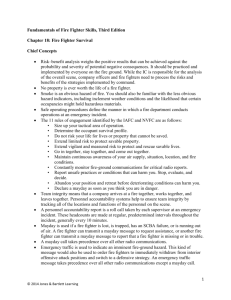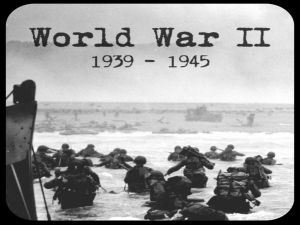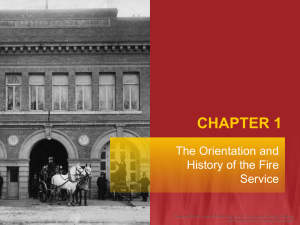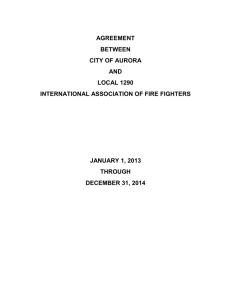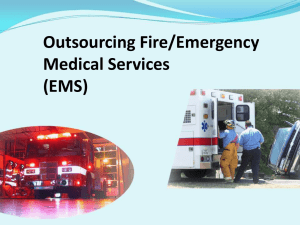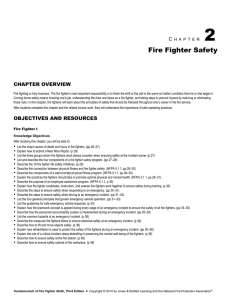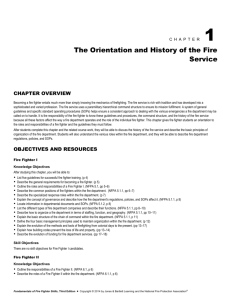Chapter 2: Fire Fighter Safety
advertisement
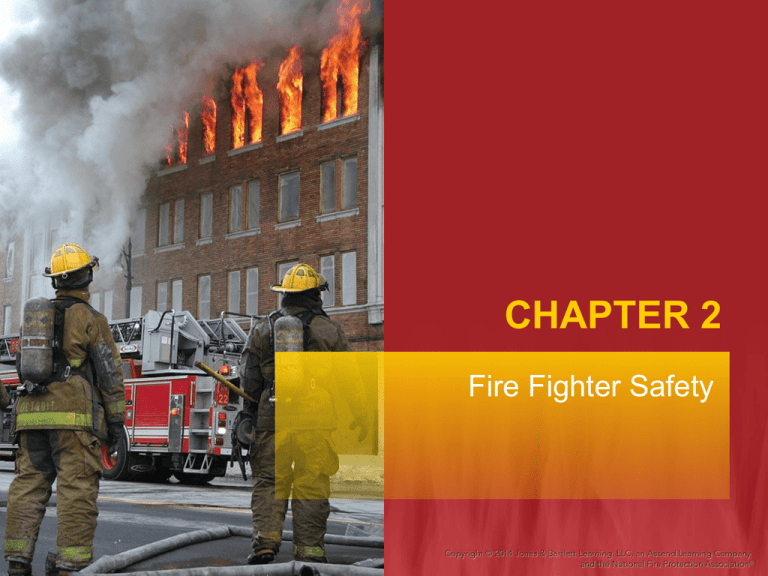
<Insert Chapter 2 COP> CHAPTER 2 Fire Fighter Safety Fire Fighter I Objectives • List the major causes of death and injury in fire fighters. • Explain how to submit a near miss report. • List the three groups whom fire fighters must always consider when ensuring safety at the incident scene. • List and describe the four components of a fire fighter safety program. Fire Fighter I Objectives • Describe the 16 fire fighter life safety initiatives. • Describe the connection between physical fitness and fire fighter safety. • Describe the components of a well-rounded physical fitness program. Fire Fighter I Objectives • Explain the practices fire fighters should take to promote optimal physical and mental health. • Describe the purpose of an employee assistance program. • Explain how fire fighter candidates, instructors, and veteran fire fighters work together to ensure safety during training. Fire Fighter I Objectives • Describe the steps to ensure safety when responding to an emergency. • Describe the steps to ensure safety when driving to an emergency incident. • List the four general principles that govern emergency vehicle operation. • List the guidelines for safe emergency vehicle response. Fire Fighter I Objectives • Explain how the teamwork concept is applied during every stage of an emergency incident to ensure the safety of all fire fighters. • Describe how the personnel accountability system is implemented during an emergency incident. Fire Fighter I Objectives • List the common hazards at an emergency incident. • Describe the measures fire fighters follow to ensure electrical safety at an emergency incident. • Describe how to lift and move objects safely. Fire Fighter I Objectives • Explain how rehabilitation is used to protect the safety of fire fighters during an emergency incident. • Explain the role of a critical incident stress debriefing in preserving the mental well-being of fire fighters. • Describe how to ensure safety at the fire station and outside of the workplace. Introduction • Firefighting is inherently dangerous. • Departments must do what they can to reduce known hazards and dangers. • The final responsibility for personal safety falls to the individual fire fighter. Causes of Fire Fighter Deaths and Injuries • Each year 80 to 100 fire fighters are killed in the line of duty in the United States. Causes of Fire Fighter Deaths and Injuries • According to the National Fire Protection Association (NFPA), 71,875 fire fighters were injured in the line of duty in 2010. Injury Prevention • Every team member is responsible for preventing injuries. • Priority of safety on the fire ground is: – Self (personal safety) – Other team members – Everyone else Injury Prevention • A successful safety program will address: – – – – Standards and procedures Personnel Training Equipment Standards and Procedures • Fire service safety is governed by: – NFPA 1500 – State and federal agencies programs, such as the Occupational Safety and Health Administration • Every department should have standard operating procedures (SOPs). Standards and Procedures • The Incident Command System (ICS) is used in the command and control of emergency incidents. • Each department should have a health and safety committee. Personnel • A safety program is only as effective as the individuals who implement it. • Freelancing is extremely dangerous and has no place on the fire ground. Personnel • Incident safety officer – – – – Designated member of the fire department Primary responsibility is safety. Reports directly to the IC Has the authority to stop any action deemed to be unsafe Training • Knowledge and skills from training are essential for safety. • Fire fighters must continually seek out additional courses and work to keep their skills current. Equipment • Fire fighters must know how to use equipment properly and operate it safely. • Equipment must be properly maintained. • Follow manufacturers’ operating instructions and safety procedures. Reducing Fire Fighter Injuries and Deaths • Requires the effort of every firefighter • Most reported injuries and deaths are the result of preventable situations. • The goal of the National Fallen Firefighters Foundation is to reduce line-of-duty deaths. Reducing Fire Fighter Injuries and Deaths Safety and Health • A healthful lifestyle includes: – A balanced diet – Weight training – Cardiovascular exercises Safety and Health • Get adequate amounts of sleep. • Spend at least an hour a day in physical fitness training. • Drink up to a gallon of water each day. • Avoid tobacco products entirely. • Never work under the effects of alcohol or drugs. Employee Assistance Programs (EAP) • Provide help with a wide range of problems • Fire fighters who use an EAP can do so with complete confidentiality and without fear of retribution. Safety During Training • Proper gear and teamwork are important. • Do not attempt anything beyond your ability or knowledge. • Do not freelance during training! • An injured fire fighter should not return until medically cleared for duty. Safety During the Emergency Response • Walk quickly to the apparatus; do not run. • Personal protective gear should be properly positioned. • Comply with all traffic laws. Safe Driving Practices • Motor vehicle collisions are the second leading cause of fire fighter deaths. • Emergency driving requires added considerations. • Collisions consist of a series of separate collision events. Laws and Regulations Governing Emergency Vehicle Operation • Emergency vehicle operators are subject to traffic regulations. • Exemptions are legal only when operating in emergency mode. • Operator can be found liable. • An exemption does not relieve the driver from reasonable care. Standard Operating Procedures (SOPs) for Personal Vehicles • The use of personal vehicles to respond to fire and Emergency Medical Services (EMS) calls constitutes a fire department function. • Fire departments should have SOPs that dictate the use of personal vehicles. Safe Driving Begins With You • The attitude and ability of the vehicle operator is a major factor in vehicle crashes. • Know the state and local laws relating to motor vehicle operations. • Emergency driving requires good reactions and alertness. Vehicle Collision Prevention • • • • Anticipate the road and road conditions. Make allowances for weather conditions. Be alert for other emergency vehicles. Drive with a cushion of safety. The Importance of Vehicle Maintenance • It is important to perform regular maintenance on fire department vehicles and your personal vehicle. Safety at Emergency Incidents • Wait for the officer in command to “size-up” the situation before acting. – Follow the officer’s instructions. – Do not freelance. Teamwork • Maintain a minimum of two fire fighters in each team. • Never work alone. Teamwork • A back-up team needs to be in place any time fire fighters are in a hazardous area. • A designated rapid intervention team should be outside the hazardous area. Accountability • Accountability system should record: – Individuals assigned to each team – Assignments for each team – Team’s current activities • Provides an up-to-date accounting of everyone who is working at the incident. Accountability • Fire fighters must learn department’s accountability system – How to work within it – How it works within the ICS Incident Scene Hazards • Be aware of your surroundings. • Always operate within established boundaries and protected work areas. • Changing fire conditions will affect safety. • Do not let down your safety guard. Using Tools and Equipment Safely • Learn to use tools and equipment properly before using them at an emergency. • Practice doing basic repairs on tools and equipment at the fire station until you can perform them quickly and safely. Electrical Safety • Always check for overhead power lines when raising ladders. • Electric power supply to the building should be turned off. • A downed line should be considered energized until confirmed dead. Lifting and Moving • Do not try to move something that is too heavy alone—ask for help. • Prevent back injuries by always bending at the knees and using the legs to lift. Working in Adverse Weather Conditions • Dress appropriately for adverse weather conditions. • Watch your footing on slippery surfaces. Rehabilitation • Provides periods of rest and recovery for emergency workers • Personnel should not be released until they are rested, refreshed, and ready for another work cycle. Violence at the Scene • Do not proceed to the scene until the police have declared it safe. • If confronted with a potentially violent situation, do not respond violently. Mental Well-being • Critical incident stress debriefing (CISD) provides a forum for personnel to discuss anxieties, stress, and emotions triggered by difficult calls. • Some departments have CISD staff available 24 hours a day. Safety at the Fire Station • Be careful when working with: – – – – – Power tools Ladders Electrical appliances Pressurized cylinders Hot surfaces Safety Outside Your Workplace • Follow safe practices when you are offduty. • An unintentional injury can end your career as a fire fighter. Summary • Every fire fighter must have a strong commitment to safety and health. • Fire fighters must always consider their personal safety and the safety of team and everyone else at the scene. • A successful safety program must have standards and procedures, personnel, training, and equipment. Summary • Safety and well-being are directly related to personal health and fitness. • Employee assistance programs are available to provide fire fighters with support or assistance. • Four general principles govern emergency vehicle operation. Summary • Emergency driving requires good reactions and alertness. • Safe driving practices will prevent most vehicle collisions. • The accountability system tracks personnel and assignments at the scene. Summary • A critical incident stress debriefing (CISD) is a forum in which firefighting and EMS personnel can discuss anxieties, stress, and emotions. • An unintentional injury can end your firefighting career.
